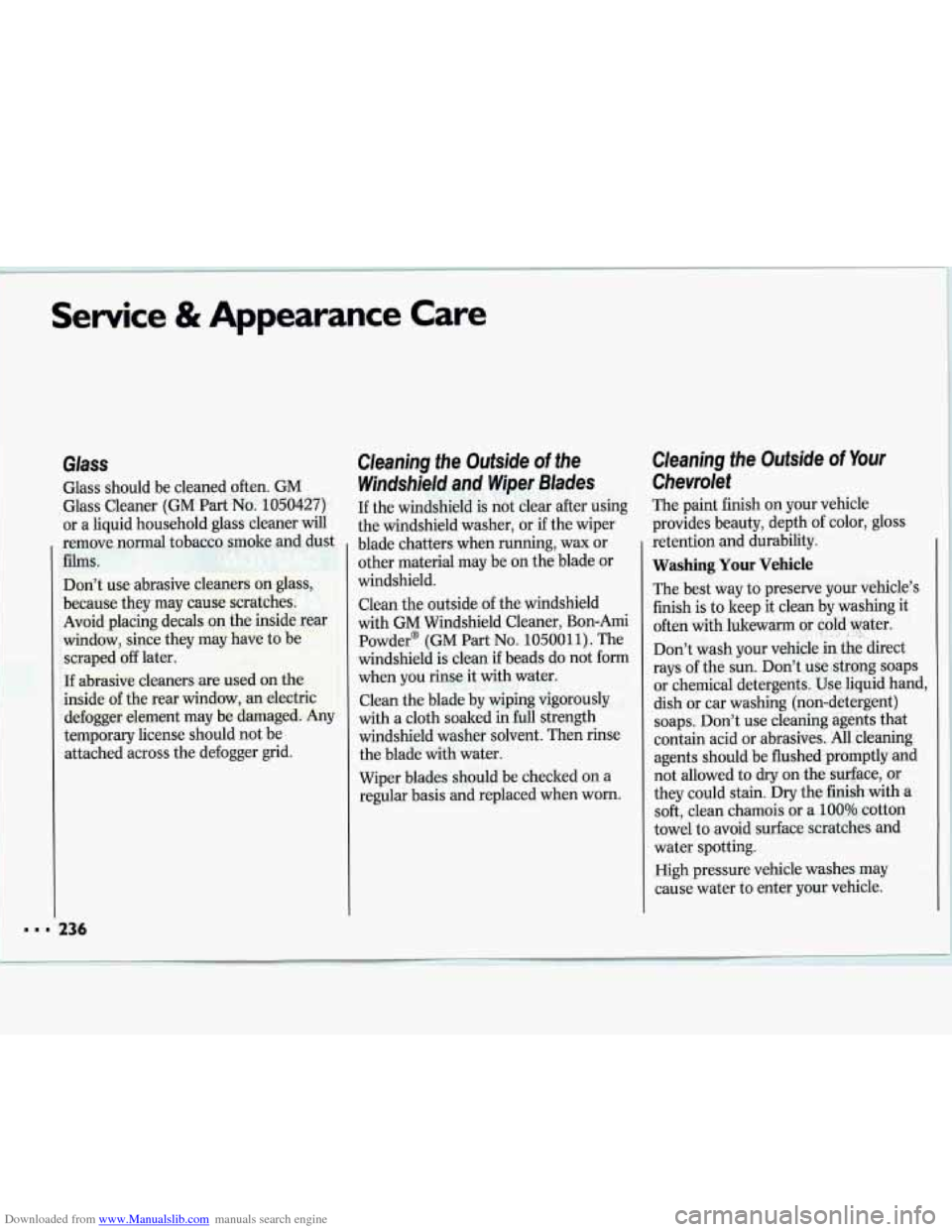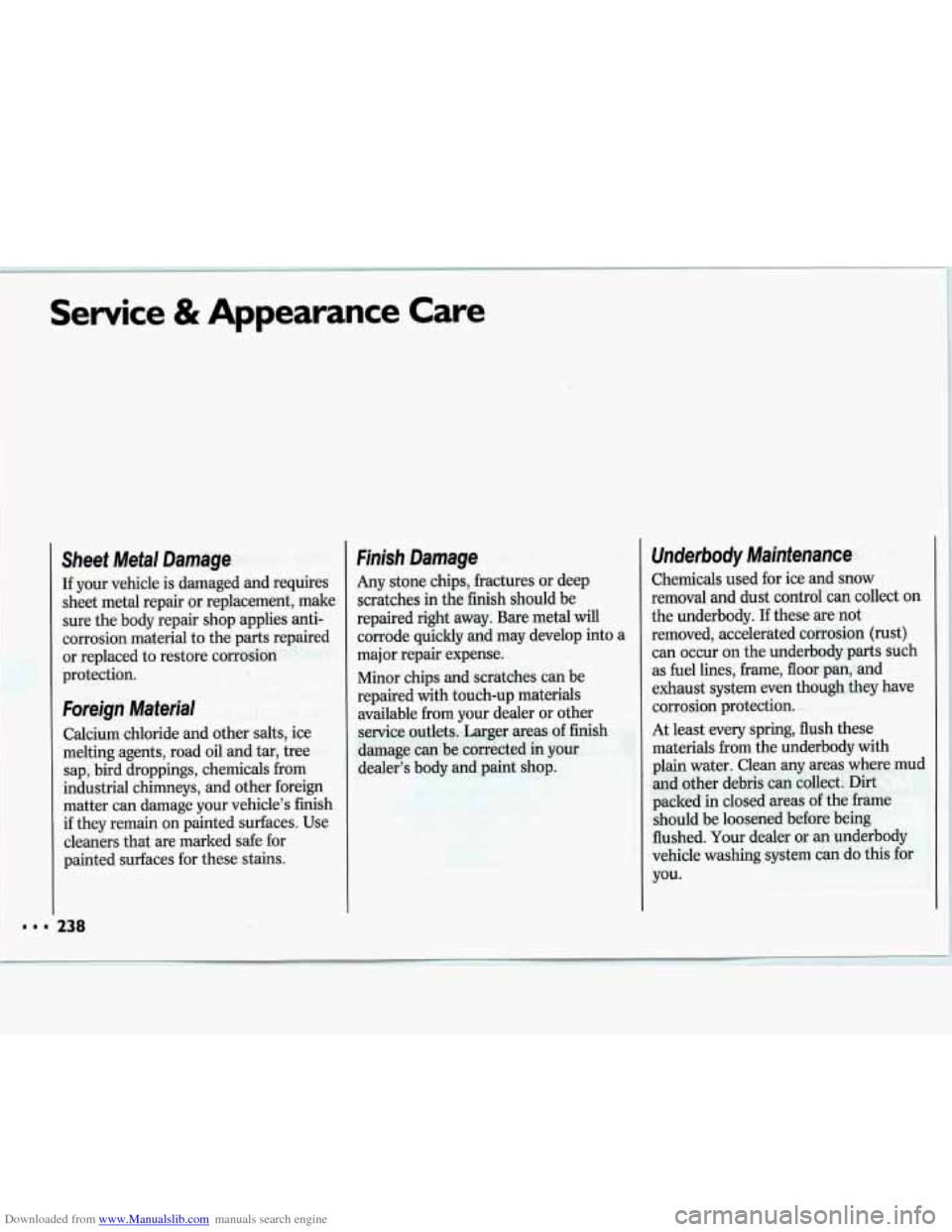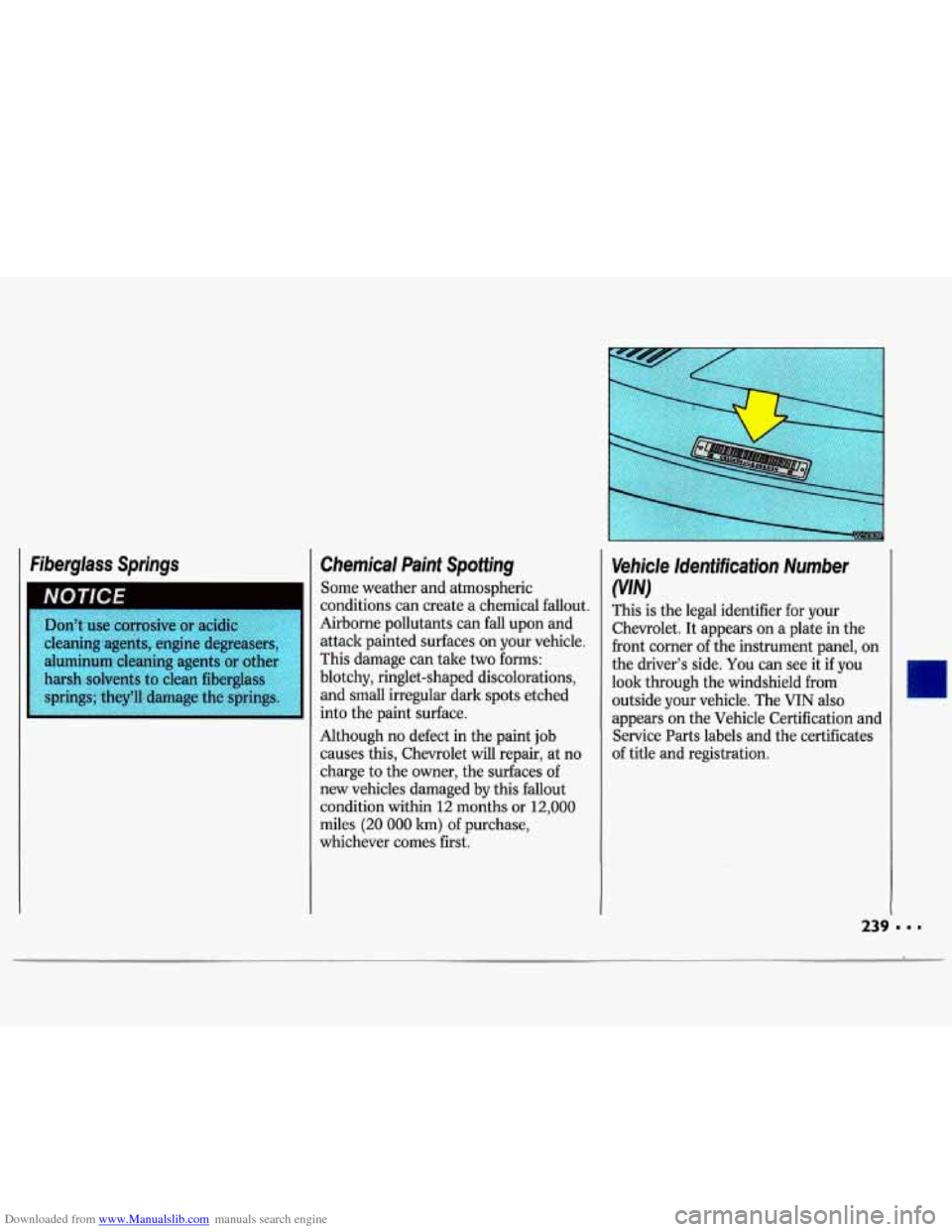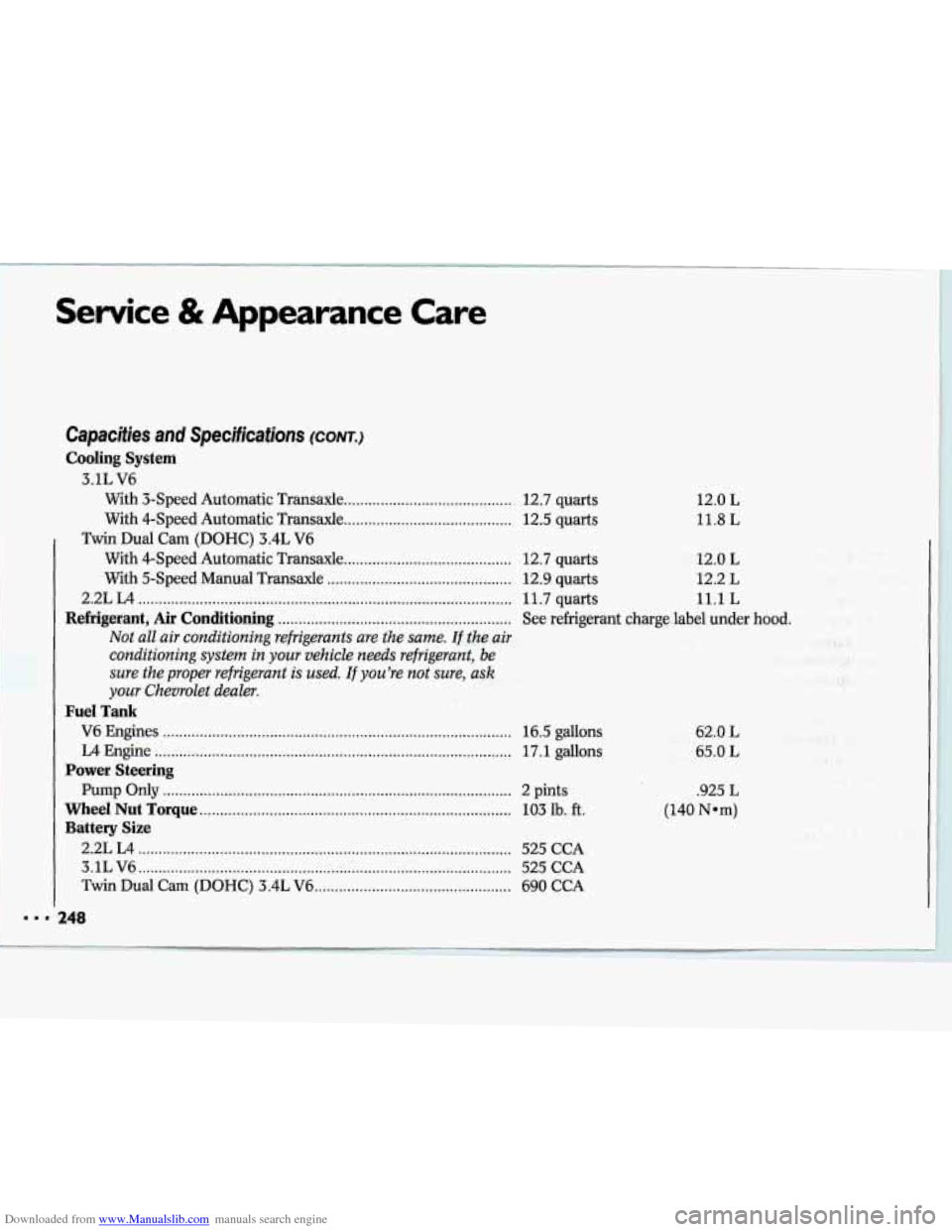Page 238 of 324

Downloaded from www.Manualslib.com manuals search engine Service & Appearance Care
Glass
Glass should be cleaned often. GM
Glass Cleaner
(GM Part No. 1050427)
or a liquid household glass cleaner will
remove normal tobacco smoke and dust
films.
Don’t use abrasive cleaners on glass,
because they may cause scratches.
Avoid placing decals on the inside rear
window, since they may have to be
scraped off later.
If abrasive cleaners are used on the
inside of the rear window, an electric
defogger element may be damaged. Any
temporary license should not be
attached across the defogger grid.
Cleaning the Outside of the
Windshield and Wiper Blades
If the windshield is not clear after using
the windshield washer, or
if the wiper
blade chatters when running, wax or other material may be on the blade or
windshield.
Clean the outside of the windshield
with GM Windshield Cleaner, Bon-Ami
Powder@
(GM Part No. 1050011). The
windshield is clean
if beads do not form
when you rinse it with water.
Clean the blade by wiping vigorously
with a cloth soaked in
full strength
windshield washer solvent. Then rinse
the blade with water.
Wiper blades should be checked
on a
regular basis and replaced when worn.
Cleaning the Outside of Your
Chevrolet
The paint finish on your vehicle
provides beauty, depth of color, gloss
retention and durability.
Washing Your Vehicle
The best way to preserve your vehicle’s
finish is to keep it clean by washing it
often with lukewarm or cold water.
Don’t wash your vehicle in the direct
rays of the sun. Don’t use strong soaps
or chemical detergents. Use liquid hand,
dish or car washing (non-detergent) soaps. Don’t use cleaning agents that
contain acid or abrasives. All cleaning
agents should be flushed promptly and
not allowed to dry on the surface, or
they could stain. Dry the finish with a
soft, clean chamois or a 100% cotton
towel
to avoid surface scratches and
water spotting.
High pressure vehicle washes may
cause water
to enter your vehicle.
Page 240 of 324

Downloaded from www.Manualslib.com manuals search engine Service & Appearance Care
Sheet Metal Damage
If your vehicle is damaged and requires
sheet metal repair or replacement, make
sure the body repair shop applies anti-
corrosion material to the parts repaired
or replaced to restore corrosion
protection.
Foreign Material
Calcium chloride and other salts, ice
melting agents, road oil and tar, tree
sap, bird droppings, chemicals from
industrial chimneys, and other foreign
matter can damage your vehicle’s finish
if they remain on painted surfaces. Use
cleaners that are marked safe for
painted surfaces for these stains.
238
Finish Damage
Any stone chips, fractures or deep
scratches in the finish should be
repaired right away. Bare metal will
corrode quickly and may develop into a
major repair expense.
Minor chips and scratches can be
repaired with touch-up materials
available from your dealer or other service outlets. Larger areas of finish
damage can be corrected in your
dealer’s body and paint shop.
Underbody Maintenance
Chemicals used for ice and snow
removal and dust control can collect on
the underbody. If these are not
removed, accelerated corrosion
(rust)
can occur on the underbody parts such
as fuel lines, frame, floor pan, and
exhaust system even though they have
corrosion protection.
At least every spring, flush these
materials from the underbody with
plain water. Clean any areas where mud
and other debris can collect. Dirt
packed in closed areas of the frame
should be loosened before being
flushed. Your dealer or an underbody
vehicle washing system can do this for
you.
Page 241 of 324

Downloaded from www.Manualslib.com manuals search engine Fiberglass Springs Chemical Paint Spotting
Some weather and atmospheric
conditions can create a chemical fallout.
Airborne pollutants can fall upon and
attack painted surfaces on your vehicle.
This damage can tale two forms:
blotchy, ringlet-shaped discolorations, and small irregular dark spots etched
into the paint surface.
Although no defect in the paint job
causes this, Chevrolet will repair, at no
charge to the owner, the surfaces of
new vehicles damaged by this fallout
condition within 12 months or 12,000
miles (20
000 km) of purchase,
whichever comes first.
Vehicle Identification Number
0
This is the legal identifier for your
Chevrolet. It appears on
a plate in the
front corner of the instrument panel,
on
the driver's side. You can see it if you
look through the windshield from
outside your vehicle. The VIN also
appears on the Vehicle Certification and
Service Parts labels and the certificates
of title and registration.
Page 242 of 324
Downloaded from www.Manualslib.com manuals search engine Service & Appearance Care
240
Engine Identification
The eighth character in your VIN is the
engine code for your
GM engine. This
code will help you identify your engine, specifications, and replacement parts in
this section.
e
AUTION rm I
Service Parts ldentification Label
You'll find this label on your spare tire
cover. It's very helpful
if you ever need
to order parts. On this label is:
Your VIN.
Its model designation.
Paint information.
A list of all production options and
special equipment.
Be sure that this label is not removed
from the vehicle.
Add-on Electrical Equipment
Page 244 of 324
Downloaded from www.Manualslib.com manuals search engine Service & Appearance Care
Glove Box Fuse Block
I-
. . . 242
W61561
Fuse
3
4
5
6
7
8
9
10
11
12
13
14
15
16
17
18
15
25
10
15
15
20
15
10 5
25
10 10
Rating Circuitry
1 10 Radio & Clock
2 15 Radio & Clock; Passive Restraint Lockout; Delcom
Bose Amplifier
Door Lock; Courtesy, Glove
Box, Underhood, Trunk,
Modular Dim Lights; Lighted Visor Mirror
Windshield Wiper
& Washer
Temp Door Motor; HVAC
& Rear Defogger; DRL
Module (Canada)
Brake Lights; ABS Control Module
ECM
Taillights; Radio
& Clock HVAC; Chime Module;
DRL Module (Canada)
Hazard Warning Flasher
Rear Defogger Timer Relay; Instrument Cluster;
Chime Module; Cruise Control; DIU Module (Canada);
ABS Lamp Driver
Instrument Panel and Switch Lights
HVAC
Turn Signals/Flasher
Not Used
ABS Control Module
Not Used
Not Used
Not Used
(AMP.)
Page 246 of 324
Downloaded from www.Manualslib.com manuals search engine Service & Appearance Care
Passenger Side Underhood Electrical Center
Fuee Rating Circuitry
(AMP*)
1 20 AIR Pump (3.4L Manual)
2 15 Trunk Release, Back-up Lights (Auto)
3 20 ECM; Fuel Pump
4 Not Used
5 Not Used
6 Not Used
7 10 Direct Ignition System
8 10 Fuel Injectors
9 Not Used
10
15 A/C, SOL EGR (2.2L), Secondary Cooling Fan, Generator,
11 10 TCC; AIR Pump (3.4L Manual) ; Primary Cooling Fan (3.1 L)
Digital EGR, Purge Canister, Back-up Lights (3.4L Manual)
1 1.. 244
Relay Rating Circuitry
(AMP.)
12 Fuel Pump
13 AIR Pump (3.4L)
14 Secondary Cooling Fan
15 Primary Cooling Fan
16 A/C Clutch Coil
Fusible Elements
17 60 Starter Solenoid
18 30 Cooling Fan (2.2L, 3.1L)
19 60 Blower Motor
20 60 Cooling Fan
21 30 Fuse Block
60 Cooling Fan (3.4L)
Y
Page 248 of 324
Downloaded from www.Manualslib.com manuals search engine Service & Appearance Care
Headlight Wiring
The headlight wiring is protected by a
circuit breaker in the component center.
An electrical overload will cause the
lights to
go on and off, or in some cases
to remain off. If this happens, have your
headlight system checked right away.
Windshield Wipers
The windshield wiper motor is
protected by
a circuit breaker and a
fuse.
If the motor overheats due to
heavy snow, etc., the wiper will stop
until the motor cools.
If the overload is
caused by some electrical problem, have
it fixed.
Power Windows and Other Power
Options
Circuit breakers in the fuse panel
protect the power windows and other
power accessories. When the current
load
is too heavy, the circuit breaker
opens and closes, protecting the circuit
I
until the problem is fixed.
Page 250 of 324

Downloaded from www.Manualslib.com manuals search engine Service & Appearance Care
Capacities and Specifications (CONT.)
Cooling System
3.1L V6 With 3-Speed Automatic Transaxle
......................................... 12.7 quarts
With 4-Speed Automatic Transaxle
......................................... 12.5 quarts
With 4-Speed Automatic Transaxle
......................................... 12.7 quarts 12.0 L
With 5-Speed Manual Transaxle 12.9 quarts 12.2 L
Twin Dual
Cam (DOHC) 3.4L
V6
-%<&? I> -- .............................................
2.2L L4 ........................................................................\
................... 11.7 quarts 11.1 L :,gRB",i A
Not all air conditioning refrigerants are the same. If the air &p&!#j ... 2
conditioning system in your vehicle needs refrigerant, be &3%Si hkL
sure the proper refrigerant is used. If you're not sure, ask .=@, , 'i
your Chevrolet dealer.
,-
Refrigerant, Air Conditioning ......................................................... See refrigerant charge label under hood. ;I ~s~t:
Fuel Tank
........................................................................\
.............
........................................................................\
............... V6 Engines 16.5 gallons
L4 Engine 17.1 gallons
Power Steering
Wheel Nut Torque
........................................................................\
.... 103 lb. ft.
Battery Size
, Pump Only ........................................................................\
............. 2 pints
2.2L L4
........................................................................\
................... 525 CCA
3.1L V6
........................................................................\
................... 525 CCA
Twin Dual Cam (DOHC) 3.4L V6
................................................ 690 CCA
... 248
12.0 L
11.8 L
62.0 L 65.0 L
.925 L
(140 Nom)